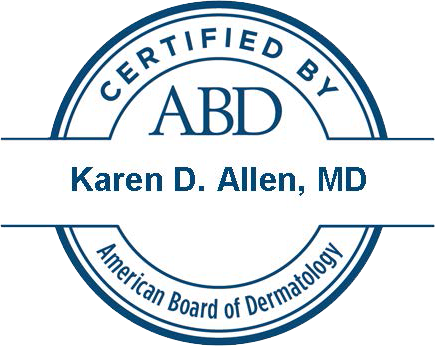715 Tank Farm Road
San Luis Obispo, CA 93401
805 543-4488
View map and directions
Karen D Allen MD
You are here
Rosacea
Rosacea is a chronic skin condition that causes facial redness, acne-like pimples, visible small blood vessels on the face, swelling and/or watery, irritated eyes. This inflammation of the face can affect the cheeks, nose, chin, forehead or eyelids. More than 14 million Americans suffer from rosacea. It is not contagious, but there is some evidence to suggest that it is inherited. There is no known cause or cure for rosacea. There is also no link between rosacea and cancer.
Rosacea generally begins after age 30 and goes through cycles of flare-ups and remissions. Over time, it gets ruddier in color and small blood vessels (like spider veins) may appear on the face. If left untreated, bumps and pimples may form, the end of the nose may become swollen, red and bulbous and eyes may water or become irritated.
Rosacea occurs most often among people with fair skin who tend to blush or flush easily. It occurs more often among women than men, but men tend to suffer from more severe symptoms. Most patients experience multiple symptoms at varying levels of severity. Common symptoms include:
- flushing
- persistently red skin on the face
- bumps or acne-like pimples
- visible blood vessels on facial skin
- watery or irritated eyes
- burning, itching or stinging of facial skin
- skin roughness and dryness
- raised red patches
- swelling (edema)
These symptoms may also appear on the neck, chest, scalp and ears.
Research conducted by the National Rosacea Foundation found that the leading triggers for rosacea are:
- sun exposure
- hot or cold weather
- emotional stress
- wind
- alcohol
- heavy exercise
- spicy foods
- hot baths
- heated beverages
- some skin care products
- humidity
- indoor heat
While there is no cure for rosacea and each case is unique, your doctor will probably prescribe oral antibiotics and topical medications to reduce the severity of the symptoms. When the condition goes into remission, only topical treatments may be needed. In more severe cases, a vascular laser, intense pulsed light source or other medical device may be used to remove any visible blood vessels and reduce excess redness and bumpiness on the nose.
To help reduce the incidence of flare-ups, a gentle daily skin care routine is recommended that includes the use of mild, non-abrasive cleansers, soft cloths, rinsing in lukewarm water (not hot or cold), and blotting the face dry (not rubbing). Additionally, individuals with rosacea need to protect themselves from sun exposure by using sunscreens with SPF 15 or higher and sunblocks that eliminate UVA and UVB rays. Patients are also encouraged to keep a record of flare-ups to try and determine the lifestyle and environmental triggers that aggravate the condition.



